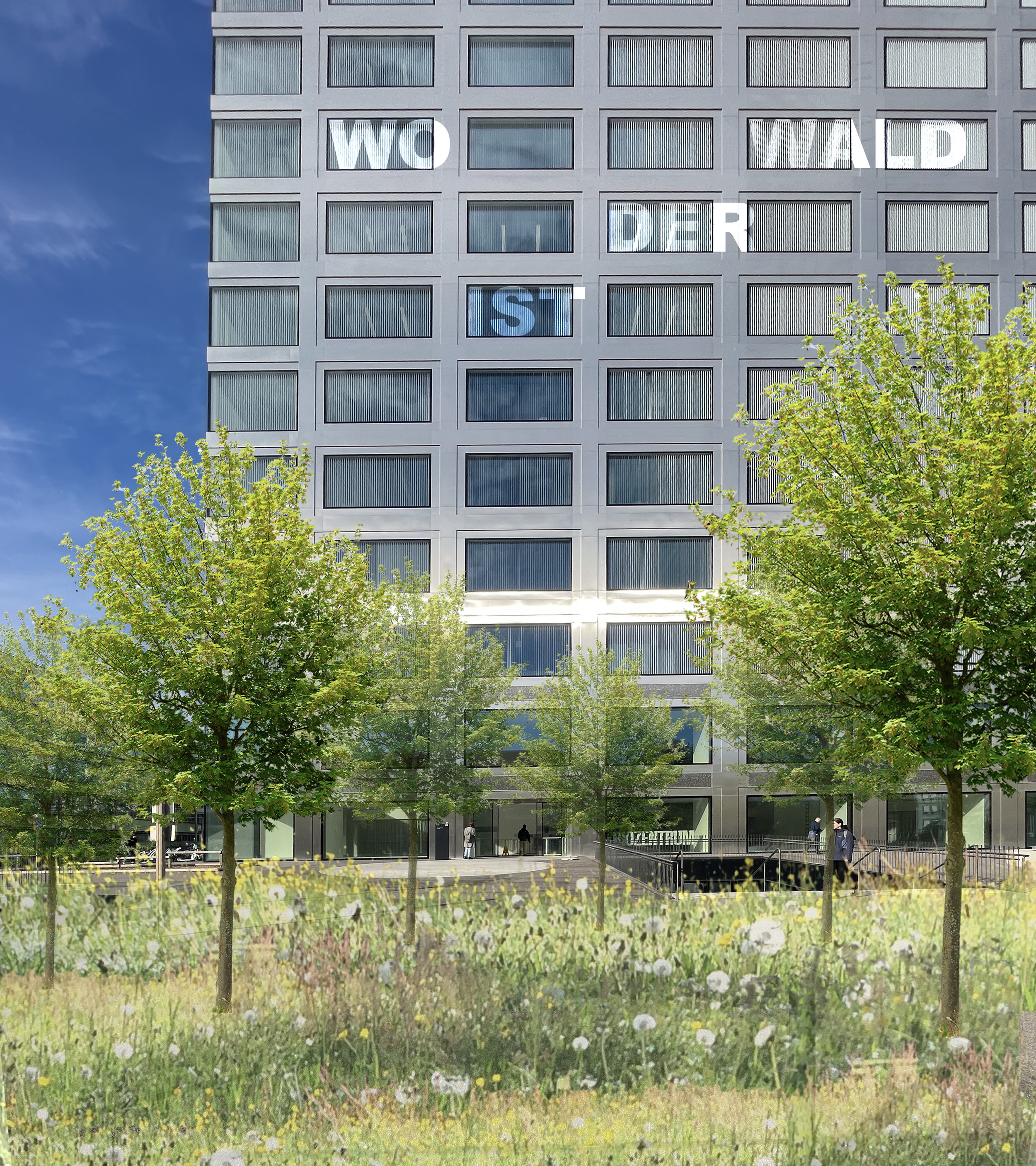Studio Emma Thomas engages in landscape architecture, design, and occasional provocation.Contact us.Follow us.Vitra Headquarters
Birsfelden, 2021-2023
At Vitra's headquarters in Birsfelden, a new connection was desired between the Frank Gehry-designed offices and an adjacent shed building that houses a café and shared workspace.
The concept for the project stems from the site's unique location between a historic oak forest and a traditional industrial area. The asphalt parking lot is replaced by 19 oak trees, 200 m2 of drought-tolerant perennials, 500 m2 of meadow, an expanded bicycle parking area, and an outdoor seating area for employees.
The ruderal planting strategy alludes to the spontaneous vegetation often found in post-industrial, disturbed areas. In addition, this approach, combined with the establishment of a ‘Magerwiese’ and Zukunft-Eiche, allows for a very low maintenance approach to the site. The proposal does not necessarily create an instant landscape, but one that will evolve and improve over time and provide sufficient shade for the seating area as the trees grow.
Landscape measures like this can play a critical role in encouraging more ecological, forward planning and incentivizing greener modes of transportation - public transit and bicycles. Such steps taken by CEO’s are models for the future.
All photos © Colin Gschwend from Krautkleid.






A Letter to the Editor
Provocation 01
Why does Basel still have a love affair with its Asphalt? A story of missed opportunities.
When I moved to Basel 15 years ago I was mesmerized by the precision and sexy smoothness of its asphalt surfaces. Brilliant, efficient surface I thought. I even made an Instagram post about it in 2014, extolling the beauty of “Swiss Asphalt”. I marveled at the “fancy asphalt” with large aggregate that Herzog & de Meuron was using in its Rheinschanze courtyard and that Vogt Landschaftsarchitekten used in its Elisabethenanlage project.
A lot has changed in the last 15 years. The summers in Basel are increasingly hotter. The heatwaves that once occurred only once in the summer for 4-5 days, happen a few times and stick around far longer. Indeed Switzerland “ is warming at more than double the rate of the global mean”.[1]
Asphalt as a default surface material no longer makes sense in our new climate reality (and also within the context of Basel as Schwammstatt). Trees are more and more important within an urban context – for biodiversity of course but also given our new climate reality, they are crucial for reducing heat related deaths. The benefits of trees within an urban context are well-proven and indisputable.
Asphalt and trees do not make for a happy marriage. Trees need impervious surfaces for water absorption. Asphalt is not a permeable surface.
And yet, there is one new project after another in Basel where the main components are asphalt and a limited number of trees. Where the vast expanses of Asphalt would lead one to believe that we have FCB matches happening all over the city and we need to accommodate vast throngs of people at the Biozentrum, at Wielandplatz, etc. etc.
These new project lead me to question again and again, why did we do this when we could have done…so much more!?
And to what end do I create these provocations? For three reasons:
1. So the greater public may envision what could have been and should have been.
2. So the greater public may begin to brainstorm and to demand ways in which these conditions could be altered.
Why can’t we fill the fountain in front of the Biozentrum with trees and soil because ecologically and practically that would accomplish a lot more (shade for users, trees for birds)
Why can’t we tear up the eye-sore circle of asphalt in front of the Kunstmuseum and plant a Magerwiese instead
Why don’t we demand that the security bollards in front of the Synagogue be surrounded by trees and meadow rather than asphalt?
3. Lastly and most importantly so we can insist that in the planning of ALL projects going forward, trees come FIRST in the planning process.
We don’t first ask ourselves, where do the pipes go? No! We first ask ourselves, where do the trees go and how can the pipes be laid around them.
In all Competition briefs the first requirement is how many trees should be planted per square meter, NOT how many car parking spaces should be appropriated per square meter.
In the planning of all underground parkings we require 2m of soil depth above, no exceptions!
I create these “provocations” because it is time that all Baslers realize and demand that trees should come first; they have to come first. We as a city have the know-how, the money and the will to create better public spaces where trees are king, not asphalt.
[1] https://www.nytimes.com/2023/01/15/world/europe/switzerland-skiiing-alpine-villages-no-snow.html



